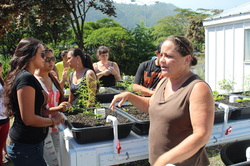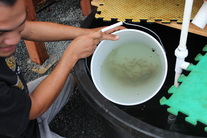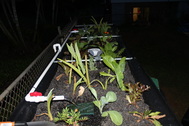




 It took a while before we finally got our aquaponics system going. We had been thinking about it for a while and then began to do research on it which took even longer. These systems could provide us food in the limited amount of space we had to grow which meant it was definitely a technique which we wanted to test out in regards to small-space growing. Research included a lot of google searching, online and youtube.com video watching, some book and ctarh study deciphering, http://www.ctahr.hawaii.edu/site/, and many visits with friends how already had systems established. It was cool to kind of take the shot gun approach to research because it let our imaginations run wild, especially seeing some of the unique systems people share online. The possibility of growing our own food in such a small amount of space really intrigued us. We wanted to try it, we just needed to decide how we wanted to do it. These are some of the plants I started in my aquaponics; lettuce, kale, collard greens, kalo, carrots, olena. The cinders were finally seasoned enough to plant.  I need to send a special mahalo out to Leina'ala Bright and her kane David for all the help, advice and time they gave us to not only understand the concept, plan and imagine but also for the encouragement to continue and complete the establishment of our system. I visited them a lot, sometimes to talk story and ask questions, but most times to just stop and stare at their systems. I literally would just sit or stand there and look at the set ups, the plumbing, the fish, and just try to understand it all. I think this really helped in me visualizing our own system, because by the time I put ours together, everything was flowing pretty well. Mahalo again, Leina'ala and David.  So I got motivation to start the system through the 699 class I set up to research small-space growing systems, got some funding (money!) through Hulili (mahalo!) to run my small research project, which covered about half of the Aquaponics systems costs. There were ways in which I was coached that could have saved me a few hundred dollars but in the end, for my first system, which I wanted to try and put together myself, I went with a pre-fab system from Waimanalo Aquaponics, which I only had to transport and put together, not engineer, and a table which I was going to build myself. The table wasn't too hard to build, I just followed some carpenter's advice that I got from David on how to build tables and from staring at his tables for a while. The only thing I would have done differently is moved the legs in more so that there isn't a long expanse between them, because the weight of the system has caused it to sag in the middle a bit. Not a lot, actually very little, but still kinda bugs me. The total amount of time for the table to gather materials, cut, and assemble was about 4-6 hours. Might have been cheaper if I totalled up my hourly worth and materials cost to buy the cinderblocks and pre-fab table from Waimanalo Aquaponics. But I appreciated the knowledge I gained from that experience.  The next step in the process was getting the fish and running the systems long enough to build the organic matter in the growbed. I was told to run it for about a week before I started planting in it. I think I waited 5 days and then I started to plant. I was also told that if you take some cinder from an already established system, that the process can be done quicker. Mahalo to Leina'ala, Kai and Hale o Tuahine for the FNO free fish. They gave us about 50 baby talapia which made it safely to the fish tank.  In this picture you can see the first plantings of this aquaponic system. I wanted to be diverse in my choices of mea kanu, so I planted kale, lettuce (romaine and red leaf), collard greens, kalo and olena. Mostly everything I put in here I sprouted myself and because of how long I took to get everything together (should have planned the sprouts a little better) they went in at about 6-8 inches tall. I think it would have been better to put them in between 1 and 3 inches. Well that about does it for setting up the system, getting the fish and planting the plants. Now I just gotta maintain and see how it goes. Look for future blogs to see how the system is doing and if it is something that would seem worth it for you.
2 Comments
Jonathan
6/10/2022 05:27:02 pm
Great post! I also believe aquaponics can go one step further. It's a fantastic opportunity to reconnect with nature.
Reply
Leave a Reply. |
Mana's MalaRaymond Kaimana or "Mana" is documenting his journey as he researches and practices a hybrid of Hawaiian Planting techniques, Permaculture and other planting strategies. Archives
October 2013
Categories |
